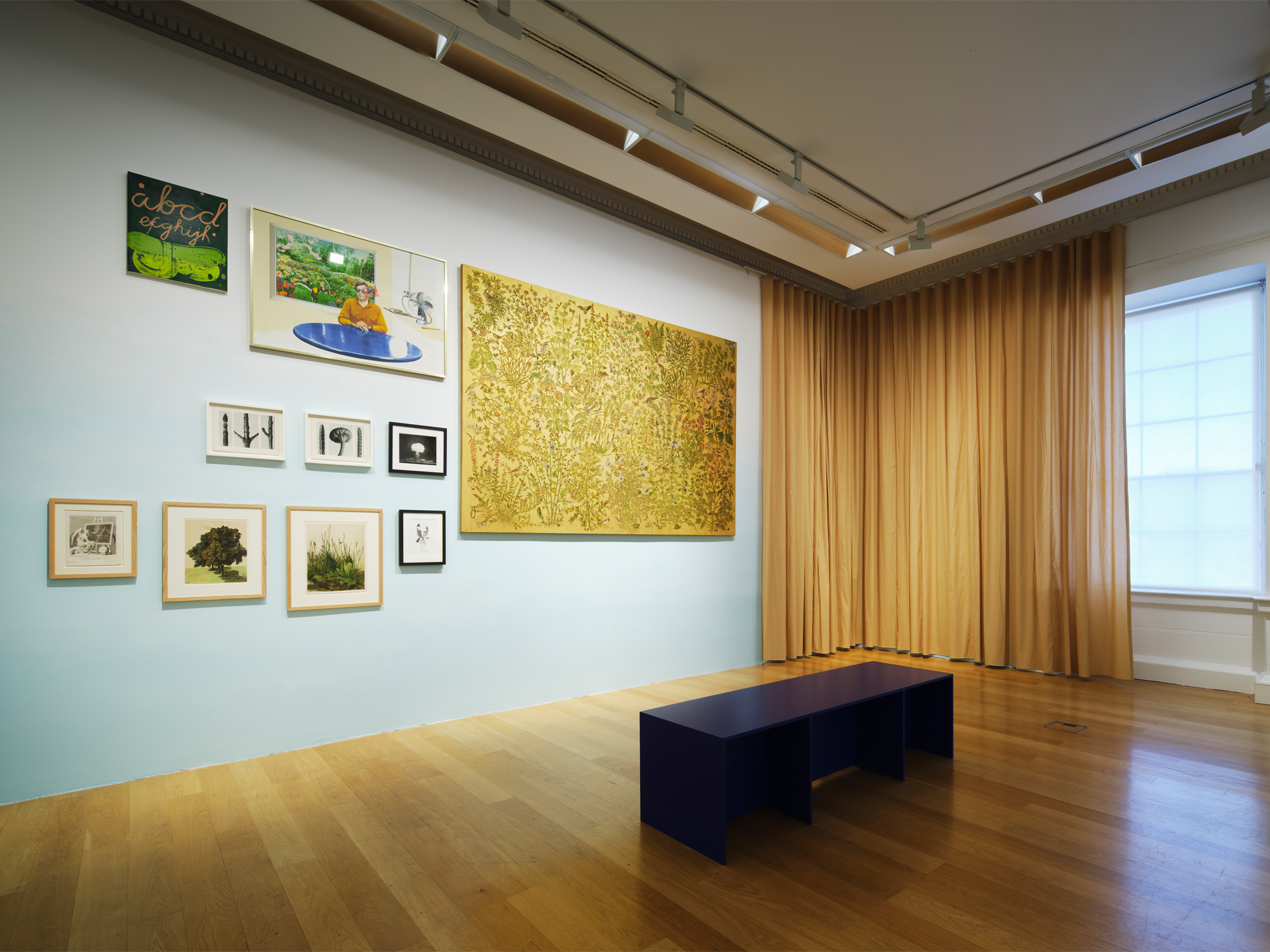VENTURING ON DANGEROUS GROUND by Dr Patricia Shaw

IMMA commissioned this magazine article by Dr Patricia Shaw on the occasion of the recent acquisition of Marie Brett’s new work Yes, But Do You Care? to the IMMA Collection. This work was made during Brett’s residency at IMMA over the period of 2019 – 2022.
…………………………………………………………………………………
The filmwork Yes, But Do You Care? , held in the IMMA National Collection is the last piece in a three-part series that builds on Marie Brett’s earlier film E.gress. E.gress is a haunting evocation of the experience of those living with the profoundly altered relationship to memory and world that we call dementia. Researching that piece, through her collborative social arts practice, brought Brett into contact with the carers, largely family members, who also live with dementia on a daily basis. E.gress was purchased for The Arts Council/An Chomharlie Ealaion collection in 2017 and shortly afterwards IMMA invited Brett to take up an Artists Residency that enabled her to research further the hidden aspects of carers’ experience that she was glimpsing. Further impetus for the work came as new legislation, in the form of the Irish Capacity Act, first drafted in 2015 and still not on the statutes at the time of writing, attempts to strengthen the ability of people to decide and act for themselves as far as their capacity allows, a move that leaves carers in an ever more difficult position. Brett collaborated with dancer/choreographer Philip Connaughton to produce first a live performed installation and then this filmic work. Yes, But Do You Care? involved considerable contribution from the Dementia Carers Campaign Network supported by The Alzheimer Society of Ireland and probes the profoundly disturbing questions raised by the ‘human right to make a bad decision’.
…………………………………………………………………
Brett: “I am trying for the work to be as brave as it can be.”
What kind of courage does an artist ask of herself, her collaborators and contributors, and now of her viewing public, that may combine to make a work brave? What fears need to be overcome? And what might be gained by such bravery?
These are questions worth exploring when an artist works with subject matter that we collectively shy away from, that we knowingly and unknowingly, relegate to the periphery of our social, cultural or political vision. When invited to give such material our full attention, the relationship between artist and viewer is a testing negotiation taking place through the work.
It begins with the title. Yes, But Do You Care? What do you know of caring? What do you care to know? Of what are you willing to speak? Yes, but, yes, but – each train of thought interrupted by simultaneous acknowledgement and an alternative point of view. Buckshot sprays of colliding concerns in which carers stand. Legislation painstakingly attempting to delineate between care for, and possible abuse of the personal rights of those whose capacity to decide for themselves is in question. “We are both dodging bullets,” says a dementia carer struggling literally with the not so simple act of helping an unwilling adult clean himself up. As a viewer, am I prepared to walk this terrain and meet its acute and lonely dilemmas?
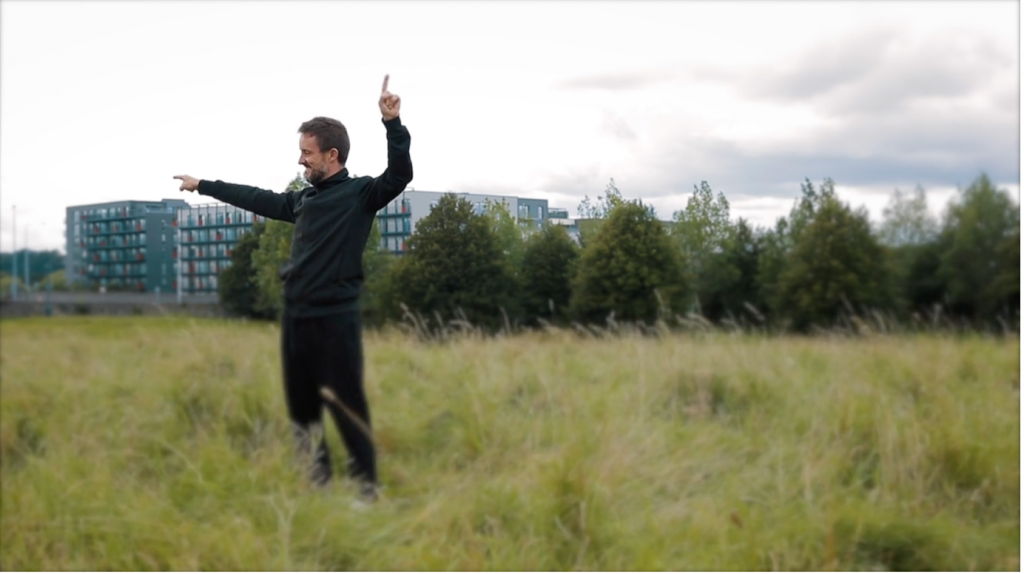
The film opens in a large field of grassy tussocks under a sombre sky, where a solitary figure is dancing – agitated gestures that twist and turn on themselves. I register behind him the many blank windows of some institutional building. I am struck by how alone the figure seems. When we leave the open field, it is for settings that are domestic and queasily unsettling. These are intimate settings, at home, in what are usually safe spaces, yet here, they seem filled with unease: a hard tiled wall with grab handles; a livid green armchair on a patterned carpet; a bathroom with toilet, basin and commode. And always that solitary dancer, moving in striking repetitive sequences.
And two voices speaking. The first voice relates the testimony of the carers, those looking after family members with dementia. I catch one brief but detailed scene after another ……after another. A tangle of rolling pins, missing limbs, tussles and cups of tea, all joined up by the same candid, informal and unemphatic tones. A second voice enters, annunciating sentences that are extracts of the proposed Irish Capacity Act. Her diction is as crisp and precise as the legal language, picking its rational way through great complexities. The voices alternate, and sometimes overlay, and occasionally go quiet. Just as the lone dancer in the field stands still for a long moment half-way through the film, a tiny pulse in his jaw.
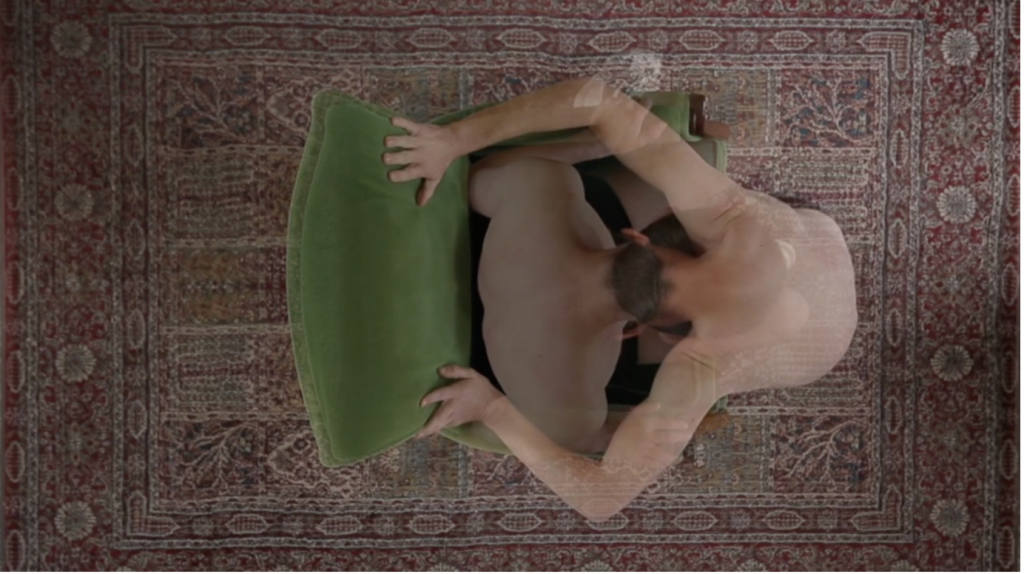
Assailed simultaneously by the voices, the stark narratives, Brett’s use of overlays and split screen scenes to frame Connaughton’s magnetic yet ambiguous movement, I am initially strangely paralysed of mind and heart. I could stop at the surface. Yes, but, enough! Or yes, but, I am not sufficiently knowledgeable to tease these dilemmas apart. I am fearful, both of what I am being asked to look at and reluctant to make the judgement calls that are buried in the very fabric of these scenes. But it is already too late, echoes have been sounded in my mind that I cannot ignore. Thus begins the next negotiation.
Brett is a visual artist whose filmic works, immersive installations and live events, (Last Breath, The Day-Crossing Farm, On The Edge of My Sky) draw her public into exploring terrain that feels dangerous, not because it involves adventuring to alien places, but rather because it is so close at hand, hidden in plain sight, at home, next door. Terrain full of perilous fears because clear moral signposts are absent, ambiguous or contradictory. Going there is like walking into a social mist, we must venture there alone, just as Brett’s subjects are often alone. The work asks us to meet something we may only have a glancing awareness of, but this is not full-frontal presentation of an issue, a view, an opinion. Brett’s social arts practice involves her in careful and intensive collaborations to probe territory with those who know it well, testing out what they will trust her with, what they themselves will gain courage together to bring to light. She then assembles an artwork as a particular aesthetic vision of that terrain and invites the public to walk into and though it, sometimes literally, always discerningly, as an immersive experience. We must negotiate our own way through the material she offers, ready to reappraise what we thought we knew, be thoroughly disconcerted, be willing to shift our ground. All this is what makes Brett’s work active as it enters the public domain, and this is more relevant than attempts to position her as an arts activist, a position she herself does not take or seek.
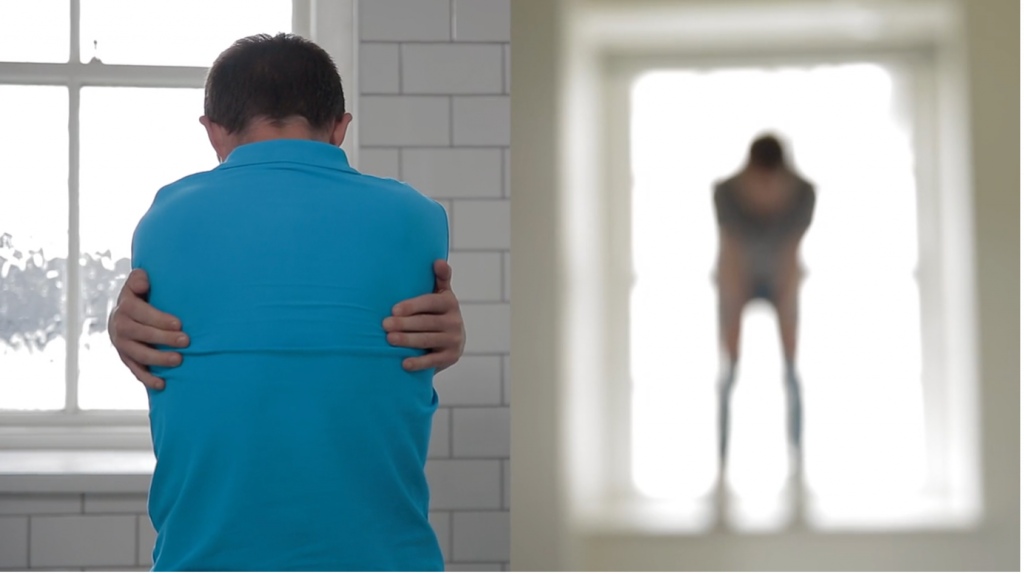
This venturing further into the work means being willing to watch again, and yet again, Then the voices, the repeating gestures and movements began to inter-penetrate and permeate, and I begin to perceive more of the experience of dementia carers. A truculent head stares out of a tiled cubicle, moving from side to side in strange, unnerving ways. A memory flashes of holding a tortoise in my hands as a child, watching the head waggling in its carapace. Trapped or sheltered? Defying or appealing? A figure runs on the spot, continuous exertion that does not get anywhere. Exhausting. I see he is boxed in, but by a window, flooded with light. The bright gaze (of a societal, legal world he is answerable to, perhaps) reduces a human person to a stick figure, vapourises flesh to a marionette. I start thinking about inhabiting the uncomfortable power relations that these circumstances involve.
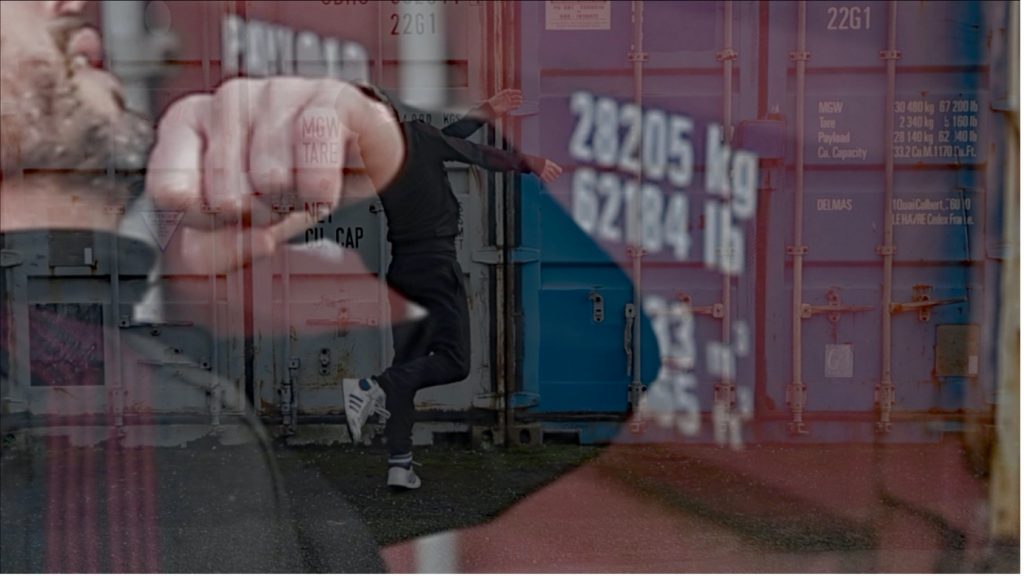
We have become all too familiar with the potential for abuse in heavily tilted power relations. Our society is wounded by revelations from so many settings where we assume care and safety, and find instead vulnerable people in peril. Within religious orders and their flock; in therapeutic consulting rooms; between bosses and junior staff at work; between staff and the elderly in nursing homes, we learn of ongoing harm being done. But, in all these circumstances it is clear who needs protection, who needs support, and our legal and professional regulatory frameworks attempt to secure that safety. But here, something else is insidiously in play.
I am reminded of Stephen Karpman’s study of the classic fairy tales of the brothers Grimm, related to his work in family therapy. He perceived certain toxic patterns arising wherever relationships of need and care morph into dysfunctionality. He proposed the idea of a triangular psychological/emotional ‘game board’ where 3 roles, taken up by 2 or more players, those of persecutor, victim and rescuer, do not hold steady, but slide unnervingly from one to another. For example, someone steps into a situation to help another, thinking they know what is needed. Disconcertingly they may find themselves accused; they feel suddenly trapped or impotent, or they become angry and are appalled to find themselves seen as persecutors themselves; confusingly they now feel they are the ones needing help. However the game unfolds, it always produces the same bad-tasting pay-off of anger, anguish, blame and shame. Karpman’s work spawned an industry of coaching and self help to show people how to stay off this game board in their everyday lives.
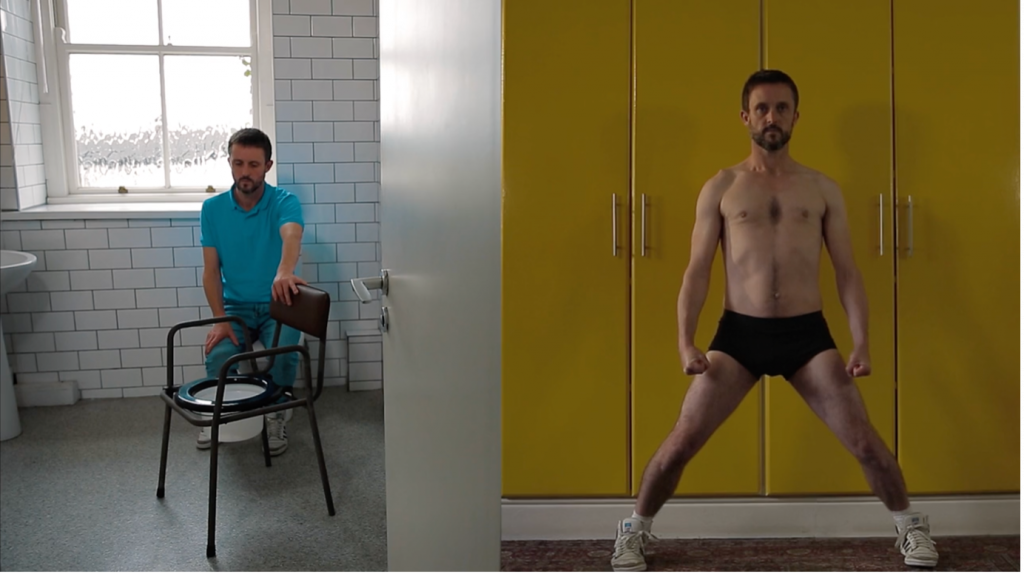
Venturing still further, I see that Brett’s film exposes yet a different twist in the scenes of family dementia care, where Karpman’s suggestions for remedying dysfunctional relationships become more difficult to apply. The capacity of the person needing care, ebbs and flows, in a way that means the world they inhabit shifts, gaps open up, into which perturbed and disturbing fears swell, where perceptions distort as in curved fairground mirrors. A Jekyll and Hyde world where a carer offering a cup of tea to her mother agonises over whether her voice tone might be the difference between a smile and a thank you, or a severe blow. And the sibling she turns to for understanding says, shocked, ‘Oh but Mammy would never do that!’ Where a carer helping someone in the bathroom, finds themselves struggling forcibly with a large, strong adult who suddenly wants no help, no longer knows who the carer is. Suddenly I glimpse what it could be like to find myself starting an action in one world of sense and completing it in quite another world, unsure when the switch occurred. And what it could be like to have to account for my judgements in a different world yet again, to the one in which those judgements arose. Brett superposes on the innocuous image of a living room armchair, multiple wraith-like images of the dancer, so that he flows between standing behind it, kneeling before it, sitting on it, struggling to escape being trapped beneath it, or toppling into the sudden dark abyss of its seat. As I view the film repeatedly I find myself wondering: when we talk of dementia ‘sufferers’, who is who? How would I carry the torment of failure, frustration, isolation, self-doubt that brews under the apparent normality of the world in which professional and legislative frameworks attempt to define important responsibilities and rights?
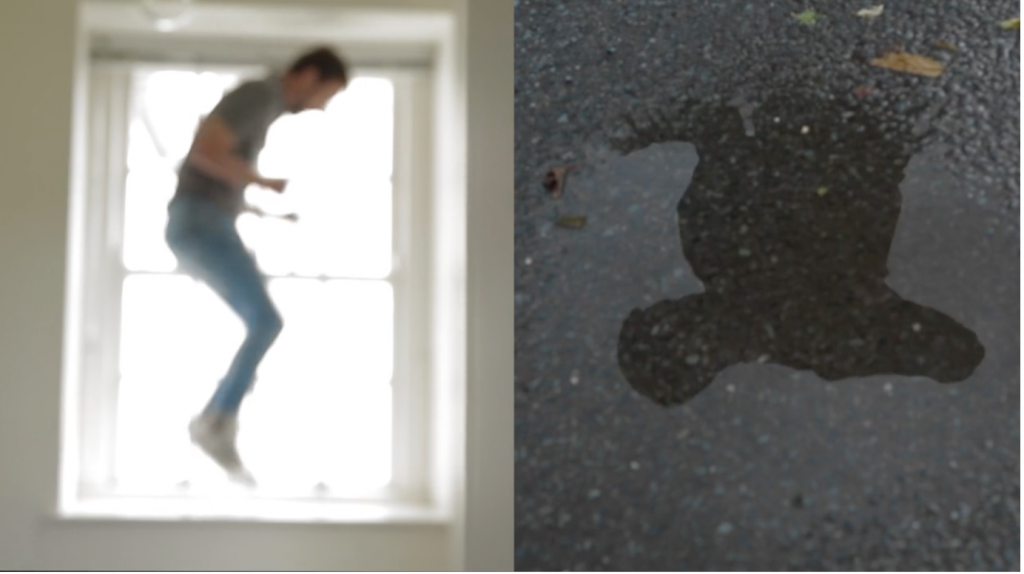
I have asked what makes a work brave and what makes it active?
Brett’s contributors did not shy away from agreeing to share the more difficult and ambivalent material of their lives. Connaughton does more than portray, he vividly enacts, the hidden lonely tensions of the dementia caring experience so we sense and recognise them in our own bodies. Brett herself does not falter in daring to show the edge of anger and anguished affection along which those with a duty of care, a bond of love to care, try to keep a footing. So yes, here is a courageous work.
If, as viewers, we dare to tread in these footsteps then we are presented with our next negotiation with the work: what are we to do with what we now see? What makes this work potentially active is that it does not present a clear problem nor advocate a solution, but rather asks how we keep seeing in the round, from every perspective, the unstable other-worldly circumstances in which dementia carers accompany those they care for. This is what makes us feel we are venturing on dangerous ground as viewers, a ground of shifting risks and ethical double binds. The temptation hovers to ignore or downplay, to take a one sided position, to hope that generalised protocols can take away the need for uniquely difficult judgement calls.
If suffering breeds in the stagnant corners of our society’s attention then an active work moves us from spectators, on-lookers, by-standers, by stirring a sense of recognition of certain experiences as potentially active in our own lives. According to Hannah Arendt being able and willing to speak together in the round of our plural experiences of a common world, is the only way we keep that world humane, continuously raising questions about how the regulatory, legislatory, professional and institutional worlds we sustain together are serving all those who live together in that world. This tests our maturity as a society as the complex tensions can never be resolved once and for all, but demand our ongoing care and vigilance from ever differing perspectives. Yes, But Do You Care? contributes to developing that kind of enlarged mentality, that mitigates the always present risk of leaving some amongst us, in this case dementia carers, to twist and turn alone.
……………………………………………………………………………………………
A solo exhibition by Marie Brett, titled The Hidden Mountain, the Fort and the Five Trees, will take place at Sirius Arts Centre, Cobh, Co Cork from 23 March to 15 October 2022. The most comprehensive presentation of Brett’s work to date the exhibition includes a newly commissioned artwork in the Centre Gallery, Ritual of Stone and Water: Pilgrimage to the Ninth Wave Multiverse – this is a scaled-down replica of a grain silo with light, quartz, charcoal, video, a quadrophonic soundscape and tree stump. In the East Gallery there is a collection of five large scale pieces reimagined through artifacts, documentation and a series of new text pieces which runs until 27 August. The film, Yes, But Do You Care? will be screened in the West Gallery from 27 Aug to 15 Oct.
On 21 July IMMA will screen the film as part of the IMMA Nights programme.
Categories
Further Reading
Marie Brett reflects on her filmwork E.gress
E.gress, by artist Marie Brett and musician Kevin O’Shanahan, maps a world of loss and change, exploring how individuals diagnosed with dementia find new ways to adjust to changing world.
Introducing AZURE at IMMA. Living with dementia
Are you living with dementia or do you know someone who is? IMMA is one of the lead partners of a programme called ‘Azure’ which aims to make art galleries and museums around Ireland dementia-friendly spaces.
At Home With Louise
To mark the tenth anniversary of Louise Bourgeois death, Brigid Mc Clean time travels to take another look at Bourgeois’s exhibition, Stitches in Time, shown at IMMA seventeen years ago.
Up Next
Exhibition Design
The Narrow Gate of the Here-and-Now: The Anthropocene
Sun Mar 13th, 2022
